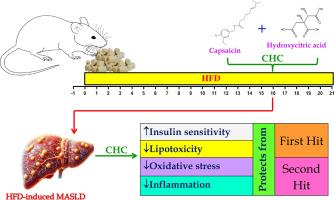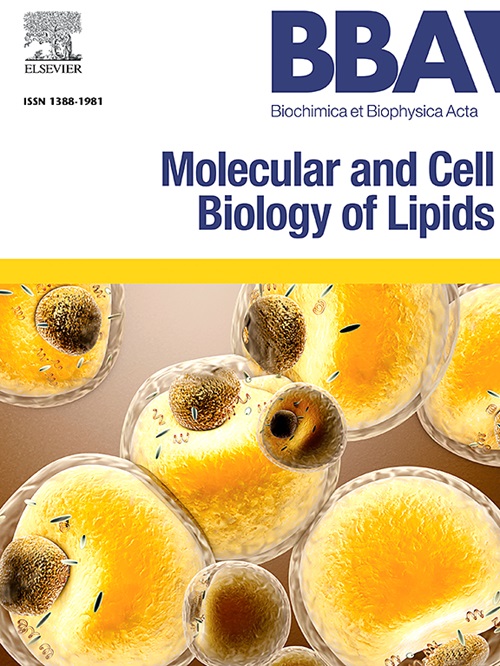Combination of hydroxycitric acid and capsaicin regulates IRS-1/AMPK-mTOR-SREBP-1c Axis/NLRP3-NF-κB/Nrf-2-ARE signaling pathways to ameliorate the two-hit process in high-fat diet-induced hepatic steatosis
IF 3.3
2区 生物学
Q2 BIOCHEMISTRY & MOLECULAR BIOLOGY
Biochimica et biophysica acta. Molecular and cell biology of lipids
Pub Date : 2025-08-23
DOI:10.1016/j.bbalip.2025.159682
引用次数: 0
Abstract
Metabolic (Dysfunction) Associated Steatotic Liver Disease (MASLD) is a complex metabolic condition, the progression of which toward steatohepatitis can be explained by the ‘two-hit’ hypothesis: the first hit involves lipid accumulation, and the second hit involves inflammation and oxidative stress. In this study, we aimed to evaluate the protective effects of a combination of hydroxycitric acid and capsaicin (CHC) against high-fat diet (HFD)-induced MASLD in rats, specifically by targeting the mechanisms associated with both hits. To establish the experimental model, rats were fed a HFD for 16 weeks, followed by treatment with CHC for 6 weeks starting on day one of the 16th week of HFD feeding. CHC treatment effectively mitigated the first hit by improving insulin sensitivity via IRS-1 upregulation and activating AMPK signaling, which in turn inhibited mTOR activity and suppressed key lipogenic markers including SREBP-1c, FAS, ACC, and PPAR-γ. Simultaneously, CHC countered the second hit by enhancing antioxidant defense through Nrf-2 and HO-1 upregulation, while attenuating hepatic inflammation via downregulation of NF-κB, TNF-α, IL-6, and NLRP3 at both mRNA and protein levels. In conclusion, CHC can effectively protect against MASLD in HFD-fed rats by defending against the “first and second hit” by mediating the IRS-1/AMPK-mTOR-SREBP-1c axis/NLRP3-NF-κB/Nrf-2-ARE signaling pathways.

羟基柠檬酸和辣椒素联合调控IRS-1/AMPK-mTOR-SREBP-1c Axis/NLRP3-NF-κB/Nrf-2-ARE信号通路,改善高脂饮食诱导的肝脂肪变性的双击过程
代谢(功能障碍)相关脂肪性肝病(MASLD)是一种复杂的代谢疾病,其向脂肪性肝炎的进展可以用“双重打击”假说来解释:第一次打击涉及脂质积累,第二次打击涉及炎症和氧化应激。在这项研究中,我们旨在评估羟基柠檬酸和辣椒素(CHC)联合使用对大鼠高脂肪饮食(HFD)诱导的MASLD的保护作用,特别是针对两者的相关机制。为建立实验模型,先给大鼠喂HFD 16周,然后从HFD喂养第16周的第一天开始给大鼠喂CHC 6周。CHC治疗通过上调IRS-1和激活AMPK信号来改善胰岛素敏感性,从而有效减轻了第一次打击,这反过来抑制了mTOR活性并抑制了关键的脂肪生成标志物,包括SREBP-1c、FAS、ACC和PPAR-γ。同时,CHC通过上调Nrf-2和HO-1来增强抗氧化防御,同时通过下调NF-κB、TNF-α、IL-6和NLRP3的mRNA和蛋白水平来减轻肝脏炎症。综上所述,CHC通过介导IRS-1/AMPK-mTOR-SREBP-1c轴/NLRP3-NF-κB/Nrf-2-ARE信号通路,可有效预防hfd喂养大鼠的MASLD。
本文章由计算机程序翻译,如有差异,请以英文原文为准。
求助全文
约1分钟内获得全文
求助全文
来源期刊
CiteScore
11.00
自引率
2.10%
发文量
109
审稿时长
53 days
期刊介绍:
BBA Molecular and Cell Biology of Lipids publishes papers on original research dealing with novel aspects of molecular genetics related to the lipidome, the biosynthesis of lipids, the role of lipids in cells and whole organisms, the regulation of lipid metabolism and function, and lipidomics in all organisms. Manuscripts should significantly advance the understanding of the molecular mechanisms underlying biological processes in which lipids are involved. Papers detailing novel methodology must report significant biochemical, molecular, or functional insight in the area of lipids.

 求助内容:
求助内容: 应助结果提醒方式:
应助结果提醒方式:


